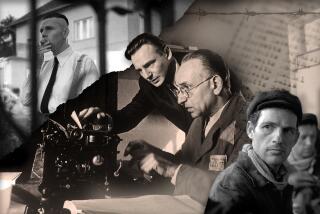Scars of German terrorism survive
- Share via
BERLIN — When “The Baader Meinhof Complex,” an epic depiction of left-wing terrorists who cut a murderous and explosive path through German politics in the 1970s, debuted here last fall, it was like taking a knife to a partially healed wound.
The film, which opened in limited release in the U.S. last week, did solid business at home, won critical plaudits and was nominated for an Academy Award in the foreign film competition.
But “Baader Meinhof” also ignited fierce debate over whether the film glorifies the terrorist Red Army Faction -- responsible for 34 deaths and numerous kidnappings and bombings -- or gives an unsparing portrayal of the gang’s brutality. And not all of the reactions have fallen along predictable lines.
The 2-hour, 24 minute-film chronicles the rise and fall of the RAF, principally focusing on its leaders Ulrike Meinhof, Andreas Baader and Gudrun Ensslin. Director Uli Edel and writer-producer Bernd Eichinger have punctuated the movie with action sequences but also provide political context. The terrorists saw their violence, in part, as a struggle against a previous generation they perceived to have been implicit in -- and to have subsequently failed to confront -- the country’s Nazi past.
Among the most vocal critics of the portrayal is the daughter of Meinhof, Bettina Rohl, who was abandoned by her mother, who left to join the RAF.
“Society has not managed to overcome this trauma until now precisely because of such unscrupulous people who insisted on keeping the RAF on the boil for their own means,” Rohl wrote in a blog in response to the movie. She added that the movie did nothing to “bury the RAF corpse” as she felt should have happened long ago, but “embalms it instead.”
Michael Buback, son of one of the gang’s murder victims, said the film pays little heed to the victims or their survivors. “We feel we’re playing the victims all over again,” he said.
But that feeling was not universal.
Jorg Schleyer, son of industrialist Hanns-Martin Schleyer, who was kidnapped and killed by the RAF in 1977, described the movie as a frank portrayal of the gang as a “wantonly brutal band of murderers . . . without damaging the memory of the victims.”
Frank Schirrmacher, editor of the highly regarded Frankfurter Allgemeine Zeitung, praised the film for finally “doing away with the histrionic fustiness” surrounding the RAF, which for 30 years, he said, had allowed “left-wing romantic filmmakers and RAF sympathizers” to nurture the idea of home-grown “feel-good terrorism” in Germany.
But Petra Terhoeven, a historian at the University of Gottingen, was critical of the film’s failure to mention Meinhof’s “statement of support” of the massacre of Israeli athletes at the Munich Olympics in 1972 by Palestinian terrorists and what Terhoeven described as the gang’s manipulation of “the dark German past” into a “self-victimization” PR strategy.
What was clear was that even though Meinhof, Baader and Ensslin are dead and their crimes extend three decades into the past, the events are still potent in German society.
And as if to underline this, just last week another member of the gang who had served her sentence was arrested in connection with the 1977 murder of chief federal prosecutor Siegfried Buback at the hands of the RAF, which is graphically depicted in the film. The woman allegedly had been linked to the envelopes containing the group’s claims of responsibility for the killing.
--
More to Read
Only good movies
Get the Indie Focus newsletter, Mark Olsen's weekly guide to the world of cinema.
You may occasionally receive promotional content from the Los Angeles Times.









